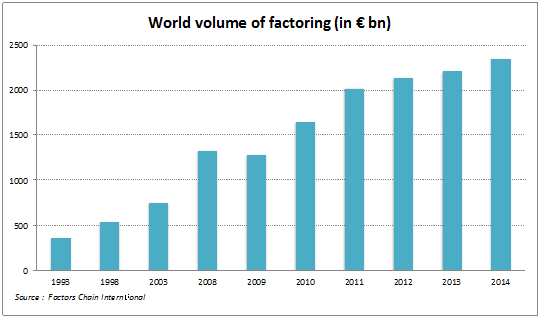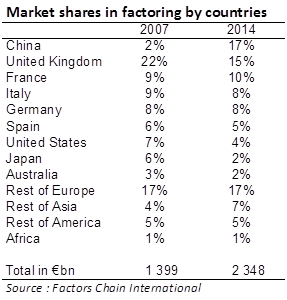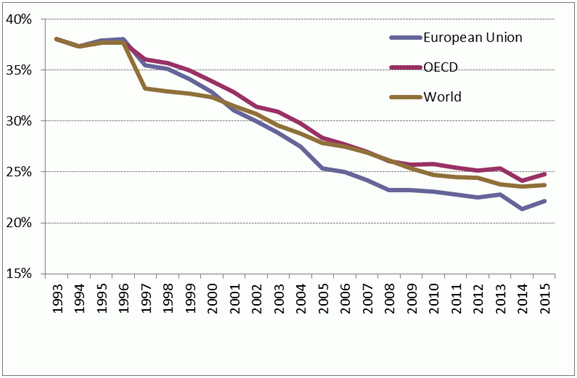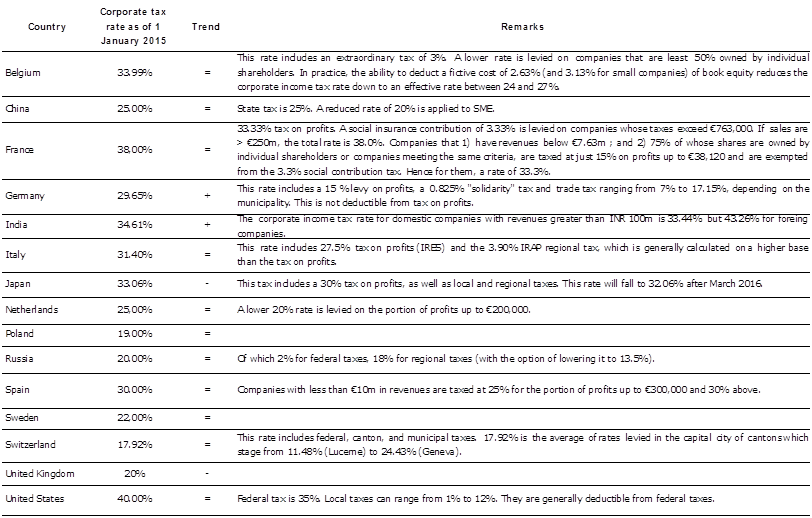Letter number 88 of September 2015
- TOPIC
- STATISTICS
- RESEARCH
- QUESTIONS & COMMENTS
News : A look at factoring
For the first time in its history, in late 2014, Total put in place a €1bn factoring programme. Of course, Total isn’t the first large group to use factoring – in France it was IBM which initiated the movement in the 1990s followed by Pernod Ricard in 2008, Sanofi in 2012, etc. But the fact that the one of the largest oil group should make use of factoring does give it the stamp of approval. It’s been a long time since we asked ourselves, rhetorically, whether factoring had come out of the shadows[1]!
It is in fact probably the fastest growing means of financing on a worldwide level at + 9.4% per year since 1993:
There are several reasons for this growth:
-
With tougher accounting standards governing deconsolidation, non-recourse factoring has become the simplest deconsolidation technique to implement and the IASB has found that there is no need to repeat itself! Moreover, and without wishing to be facetious, the IASB would be better off requiring reconsolidation than it is stubbornly seeking to impose the consolidation of operational leases on the balance sheet[2].
-
Next, banks prefer this sort of short-term loan because it is better secured for them than an overdraft or an ordinary short-term loan, because they possess the underlying asset, the quality of which they have been able to appreciate and which most often, they only acquire following the deduction of a guarantee reserve. The prudential constraints that apply to them[3] have accelerated this development, since factoring consumes less regulatory equity capital. In many countries, this is facilitated by the fact that the main factoring firms are subsidiaries of banking groups which refinance them.
-
There is more to factoring than meets the eye. Several products co-exist and provide clients with a wide choice: financing of course, but also deconsolidation, credit insurance (non-recourse factoring) and receivables management and collection services. It was this service that initially attracted IBM France to factoring.
-
Factors have of course been able to manage their growth and to bring down their unit costs in an industrial set-up - scale effects of growing volumes (BNP Paribas Factor, the French market leader with an 18% market share, employing just over 400 people), pooling, for some of them of their IT platforms.
-
The sector has innovated on a regular basis, in particular with the development of reverse factoring, which is a contract between a factor and a major customer, that defines the terms and conditions in which the suppliers of this major customer can benefit from factoring services for their turnover carried out with this major customer[4]. Reverse factoring has become established practice in certain countries (Spain, Japan). Although reverse factoring reduces the risk of invoice fraud, it is not without risk because if the major customer goes bankrupt, the factor will suffer a big loss (non-recourse factoring) or it could trigger a domino effect amount its suppliers (recourse factoring). For best practice, reverse factoring is reserved for groups whose solvency is well-established.
-
Finally, factoring has benefitted from the bad image acquired by securitisation since 2007 (subprime[5] crisis), even though the securitisation of commercial debts is very different from that of US mortgage loans.
At a worldwide level, the growth rate is 10% per year since 1995[6]. However, this strong growth has not been the same in all countries, with China exploding with an annual growth rate of 43% since 2007:
The growth of Chinese factoring is not without risk for those involved because customer audits are practically non-existent when they should help to detect organisations at a high risk of fraud, which is not just a theoretical risk. For example, Citi lost $400m in Mexico.
Readers may be surprised at the small market share of the USA, less than twice that of Belgium, when it gave a considerable boost to factoring in the 18th and 19th centuries in the textile sector and is at the origin of the introduction of this technique in many countries in the 1960s. In fact, influenced by its history, factoring declined parallel to the US textile industry in a country where asset-based lending is important, the invoice being just one guarantee among others.
Obviously, this sector is not protected from the digitalisation of the economy with the appearance of disintermediation platforms (Finekcap, Advanon, etc.) connecting investors seeking to finance invoices with companies seeking to transfer invoices. Theirs is no easy task: how is it possible, at a parallel level and for more or less similar amounts, to convert investors and companies? How is it possible to have a sufficient volume by starting out factoring invoice by invoice and not with a long-term commitment on a recurrent volume of invoices? How is it possible to develop efficient credit risk measuring tools that have been tested over several years, when like all new entrants, they risk attracting mainly the not-so-good risks? How is it possible to develop efficient processes for fighting against fraud (false invoices)?
Like in all sectors, certain players will succeed because they were able to innovate, starting out from a blank page (development of plug and play platforms on company systems), others will be bought up by existing players seeking to speed up their transformation, and finally, many will just disappear.
[1] For more on our first article on factoring, see the Vernimmen.com Newsletter n°5 July 2005
[2] For more on the IASB project on lease accounting, see the Vernimmen.com Newsletter n°77 October 2013
[3] For more on prudential constraints on banks, see the Vernimmen.com Newsletter n°82 May 2014
[4] For more on reverse factoring, see the Vernimmen.com Newsletter n°14 March 2006
[5] For more on subprimes, see the Vernimmen.com Newsletter n°28 November 2007
[6] According to Factors Chain International
Statistics : Corporate income tax around the world
The average corporation tax rate in the world in 2015 is 23.68%, showing a small increase (by 0.11%), the first one since 1995.
Source: KPMG
Corporate income tax rates rate are going down in Japan and the UK.
These rates are useful to compute corporate income taxes to be paid on pre-tax profits, to compute free cash flows or cost of capital or produce business plans. But they cannot be compared from one country to the other one to appreciate the tax burden borne by companies. Indeed in some countries some local tax are not levied on the pre-tax result but on added value, turnover or the renting value of buildings. And they are in addition to those computed on the pre-tax result and shown in this table.
Research : The influence of peer firms on financial policy
With Simon Gueguen – Lecturer-researcher at the University of Paris Dauphine
In this newsletter, we regularly look at the determinants of financial policy. Empirically, the standard determinants for researchers are the tax rate, the cost of financial stress, the informational environment and management incentives. Another determinant, the behavior of peer firms, is regularly cited as being able to influence financial policy decisions, although, for technical reasons, it is not possible to measure it accurately. The article that we present this month[1] seeks to solve this problem and attempts to measure this effect. The result obtained shows that the behavior of peer firms is a major determinant. We observed this empirically a long time ago and you can check it out in the Vernimmen[2]! We are delighted that it has now been scientifically proved.
It is not difficult to measure the correlation between the financial policy of a firm and that of its peers. The result will almost always be positive. However, correlation is not causality, and there are several interpretations that can be made.
Firstly, it is reasonable to think that peer firms (in terms of activity sector) are facing the same institutional environment and share common features. Even taking standard determinants into account when we measure the correlation between financial policies, it is possible that we overlook certain determinants. In this case, the correlation would appear positive without our being able to draw any useful conclusions there from.
Secondly, even if we succeed in isolating the influence of peer firms on financial policy, this influence can transit through two different channels:
-
the firm (in this case, its financial director) responds to the change in characteristics at peer firms (profitability, risk, growth opportunities, etc.). We then find a positive correlation between the firm’s financial policy and the financial policy of its peers because a change in the peer firms’ environment will have an impact on the financial policy of the whole group;
-
the firm responds directly to the financial policy of its peers. Only in this case can we refer to mimetism.
The technique used by Leary and Roberts involves measuring the idiosyncratic part of peer firms’ equity movements, i.e. the part that is not linked to stock market movements. The advantage of these equity shocks is that they influence the financial policy of the firm that receives them, but are not correlated between them. The study shows that shocks that affect peer firms in year N significantly influence the financial policy of the firm (financial leverage, decisions to issue debt or equity) in year N+1. Furthermore, when we add the financial policy of peers into the explanatory variables, the shock impact disappears. This means that these shocks only have an influence on firms when they impact on the financial policy of peers.
This technique enables Leary and Roberts to quantify the impact of peers on the firm's financial policy. The result obtained[3] is that a variation of the standard deviation of the peer firms’ financial leverage, leads to a 10% increase in the firm’s financial leverage[4]. This is in fact the strongest determinant of financial leverage!
The reason for this effect still has to be identified. Leary and Roberts suggest that mimetism comes from a learning and reputation effect. To support this idea, they show that small firms that are performing poorly and subject to heavy financial constraints, follow the same financial policy as the leaders, while the inverse is not true.
Fundamentally, this article merely confirms an idea that has been around for quite some time – the existence of mimetism in financial policy. But, it does prove very rigorously, thanks to its very high technicality, that the financial policy of firms is heavily determined by the financial policy of their peers.
[1] M.T. Leary and M.R. Roberts (2014), “Do peer firms affect corporate financial policy?”, Journal of Finance, vol.69, pages 139 to 177.
[2] See chapter 35 of the Vernimmen.
[3] The sample includes over 9,000 US firms between 1965 and 2008.
[4] The result is the same, whether we measure financial leverage in book value or in market value.
Q&A : What is a lead director?
Some listed companies, especially when the functions of general manager and chairman of the board of directors are performed by the same person (ArcelorMittal, AXA, JP Morgan, etc.), have appointed an independent lead director to the board of directors, who is sometimes the chairman of the appointments and compensation committee, sometimes the vice chairman of the board of directors.
The lead director has the role of leader of the independent directors, with a bit more power than the other directors, in particular the power to put items on the agenda for meetings, to call meetings of board members without the involvement of the top management, and even, if he/she is of the view that the CEO/chairman of the board is not up to the job, to take steps to replace him/her. On a daily basis, the lead director is responsible for monitoring and managing conflicts of interest and for compliance with corporate governance principles by the board and by its committees.
This practice has been imported from the USA (lead independent director) and the United Kingdom (senior independent director) and adopted in many countries.
The lead director's role is most often defined in the internal regulations of the board of directors, in the articles of association or in a special charter. It must be possible to consider him/her as independent from the company's top management and from its main shareholders and he/she must accordingly not be a former manager, even if this does sometimes happen, nor a former auditor of the company, nor a director of too long standing. These are all factors that are likely to raise concerns about the lead director's independence and impartiality.




